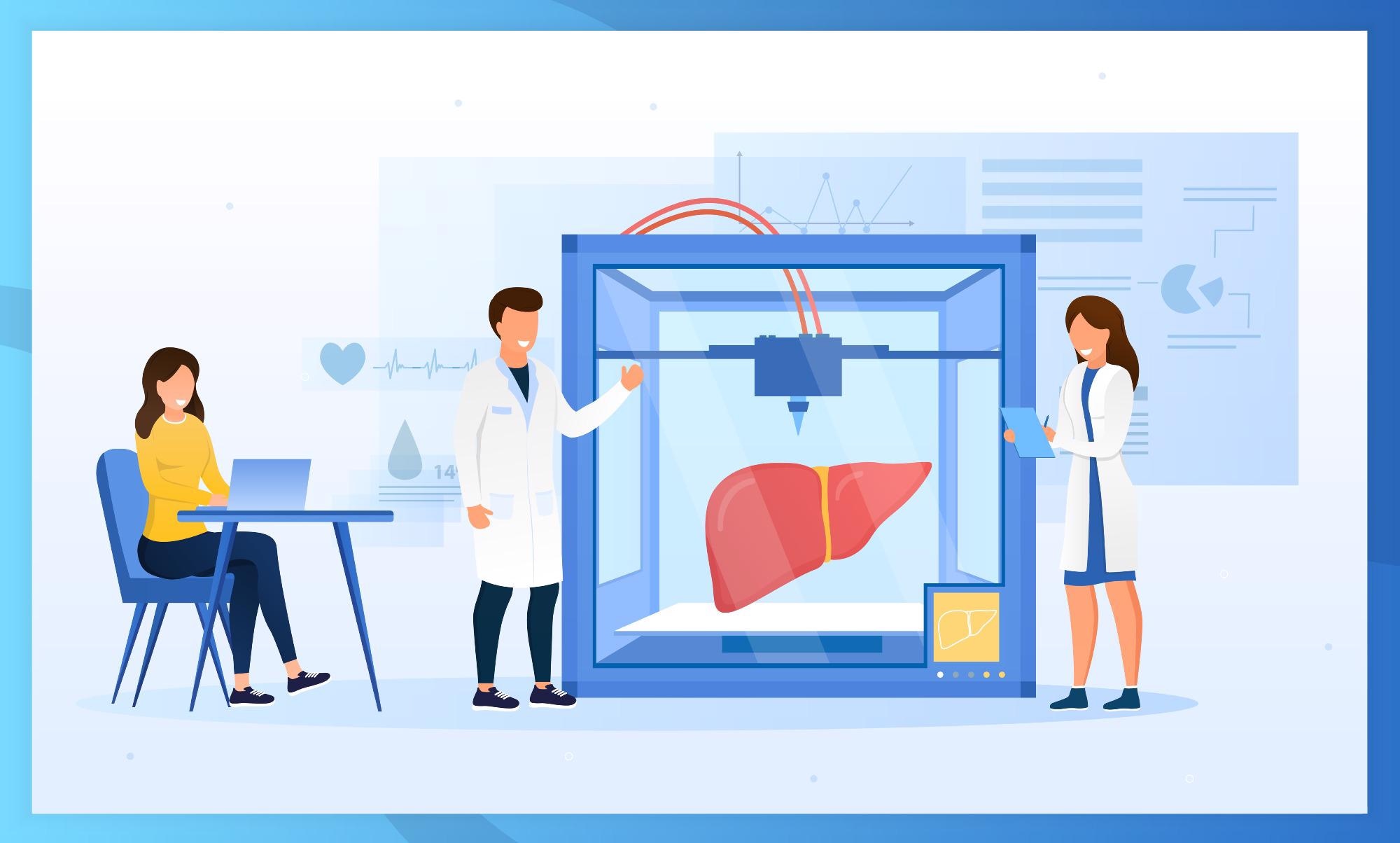 By Surbhi JainReviewed by Susha Cheriyedath, M.Sc.Jun 1 2022
By Surbhi JainReviewed by Susha Cheriyedath, M.Sc.Jun 1 2022In an article recently published in the journal Bioprinting, researchers discussed the development of a bioink formulation based on radical scavenging gelatin methacrylamide for three-dimensional (3D) bioprinting of a parenchymal liver construct.

Study: Radical scavenging gelatin methacrylamide based bioink formulation for three dimensional bioprinting of parenchymal liver construct. Image Credit: Mr.Good/Shutterstock.com
Background
3D bioprinting has emerged as a potential technology in the field of tissue engineering and regenerative medicine and is a cutting-edge technology that aids in the creation of physically identical biological alternatives. A carrier medium or bioink is used to achieve the task of cell deposition in accordance with a specific design. Bioinks that closely match the cell-extracellular matrix (ECM) and have excellent gelling qualities for various bioprinting processes are promising options for improved cell function and survivability.
Hydrogels are ideal for this application because they are structurally similar to the ECM and can be cross-linked to produce highly hydrated 3D networks. As bioinks, a variety of hydrogel systems have been investigated. Modified gelatin, also known as gelatin methacrylamide, gelatin methacryloyl, and gelatin methacrylate, all abbreviated as GelMA, is one of the most studied hydrogel systems for the bio-fabrication of tissue constructions.
The free radicals produced by photo-initiated cell encapsulation interact with the proteins, cell membrane, and deoxyribonucleic acids, causing substantial cellular damage by interfering with a variety of biochemical and physiological functions. Many antioxidants have been shown to remove pro-oxidants and scavenge free radicals in tissues.
About the Study
In this study, the authors presented the addition of ascorbic acid, a well-known free radical scavenger (FRS) molecule, to the GelMA bioink formulation to protect cell proliferation, viability, and tissue functions of 3D bio-printed parenchymal liver structures. The concentration of FRS in the bioink was tuned, and human hepatoma cells (HepG2) were 3D bio-printed.
The team provided a new photoprotective bioink formulation for the bioprinting of functional liver structures. Ascorbic acid was added to the bioink as a biologically active component. L-ascorbic acid was used in bioink formulations and liver tissue structures as a photoprotective chemical. In order to highlight the potential benefits of GelMA-FRS bioink on bio-printed liver structures, HepG2 cells were used.
The researchers tested the functional activity of the bio-printed structures. The creation of a photoprotective bioink formulation based on GelMA was also described.
Observations
Protein synthesis in GelMA-FRS (3.4) started at 50 ± 2 ng/ml on day 1 and increased linearly to 128 ± 3 ng/ml on day 7. The construct printed with GelMA bioink showed a similar trend of increasing but with a lower albumin production of 32 ± 3 ng/ml that climbed to 91 ± 8 ng/ml on the seventh day.
Cell activity in the 3.4 mM FRS bioink formulation was considerably higher at the end of 7 days than that printed with GelMA alone. The viscosity values virtually doubled from 0.0156 Pa.s at 24 °C to 9.991 Pa.s at 17 °C for GelMA-FRS (3.4), and from 0.00283 at 24 °C to 4.0155 at 15 °C for GelMA-FRS (3.4) solution, after which the curve plateaued, which confirmed the gels' stability.
Albumin secretion by GelMA-embedded cells started at 60 ± 2 ng/ml on Day 1 and increased linearly to 86 ± 4 ng/ml after 7 days. GelMA and GelMA-FRS (3.4) had compressive moduli of 1.37 ± 0.24 kPa and 0.29 ± 0.03 kPa, respectively. The porosity of the lyophilized GelMA and GelMA-FRS (3.4) hydrogels was 74.1% and 74.8%, respectively.
The results showed that using 3.4 mM FRS in the GelMA bioink formulation prevented the formation of excess reactive oxygen species (ROS) inside the cells. Furthermore, after 7 days in culture, the optimized GelMA formulation, including FRS retained and increased albumin, cell activity, and urea synthesis in the 3D construct.
Conclusions
In conclusion, this study elucidated the utility of a photoprotective and GelMA-based bioink for the 3D bioprinting of liver constructions. The results demonstrated that radical scavenging during photo-crosslinking increased the bio-printed structures' survivability and functionality.
The photoprotective GelMA-FRS (3.4) bioink-based liver construct could be a straightforward and effective way to improve liver-specific functionalities in bioengineered liver tissues. UV irradiated hepatocytes encapsulated within the new bioink formulation revealed efficient nullification of intracellular ROS while maintaining liver-specific activities.
When compared to standard GelMA, the cells in the 3D bioprinted construct had an activity of more than 150 times as well as better cell functionality. The authors stated that the structural organization and the physiological capabilities of 3D liver tissues bioprinted with heterogeneous primary cells are expected to be the focus of future research. They believe that after further testing based on regulatory criteria, this bioink formulation will be a viable option for developing transplantable liver constructions to address future organ shortage issues. They also mentioned that this technique could be used in the bio-fabrication of large liver structures that require several or longer UV irradiation sessions in the future.
More from AZoM: Use and Applications of Flame Atomic Absorption Spectroscopy
Disclaimer: The views expressed here are those of the author expressed in their private capacity and do not necessarily represent the views of AZoM.com Limited T/A AZoNetwork the owner and operator of this website. This disclaimer forms part of the Terms and conditions of use of this website.
Source:
Pai, R. R., Ajit, S., Sekar J, A., et al. Radical scavenging gelatin methacrylamide based bioink formulation for three dimensional bioprinting of parenchymal liver construct. Bioprinting e00214 (2022). https://www.sciencedirect.com/science/article/pii/S2405886622000240